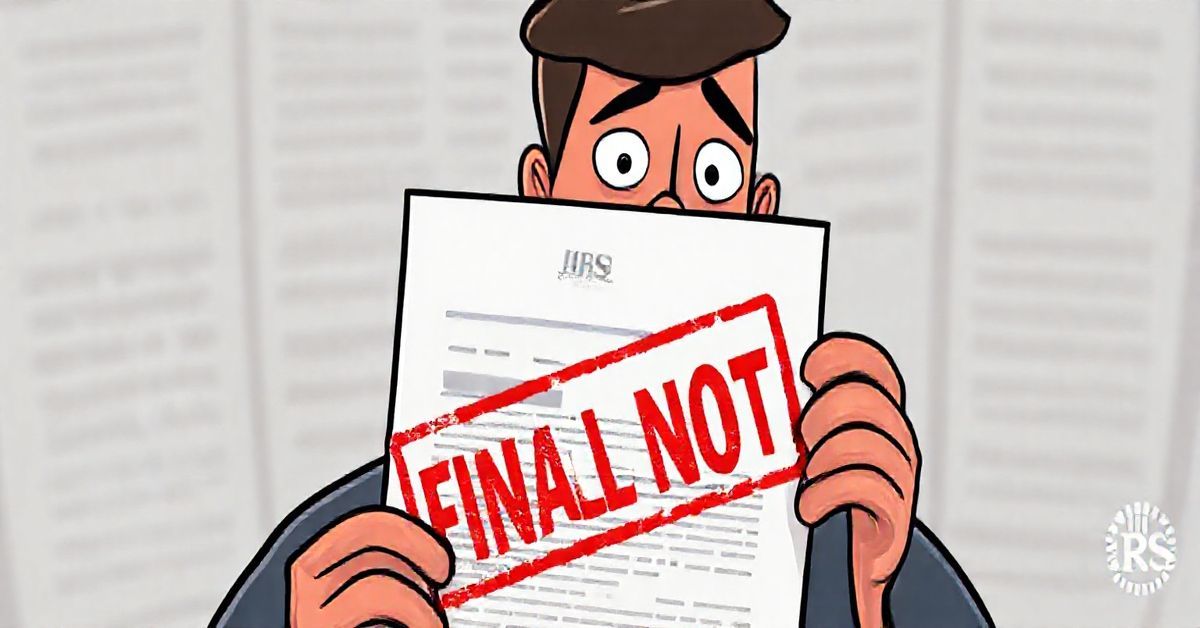Understanding IRS Letter 3391: Your Final Warning
Receiving mail from the IRS can be nerve-wracking, but finding Letter 3391 in your mailbox is particularly concerning. It’s not just another casual reminder; it’s the IRS’s way of saying, “This is your last chance.” Let’s break down what this letter means and what you need to do.
What’s the Background of IRS Letter 3391?
Imagine the IRS sends out a friendly notice about unpaid taxes. They’re hoping you’ll quickly pay what you owe, right? Well, Letter 3391 comes into play when those initial notices are ignored. The IRS typically sends several notices before this final demand. These prior notices may include reminders of the due date, statements of the balance due, and notices about potential penalties and interest. Each notice serves as a warning, a chance to resolve the issue before it escalates. Letter 3391 is the culmination of these missed opportunities. It signifies the IRS has tried other methods to get your attention, and now they’re making it clear that more serious actions are on the horizon if you fail to respond. It is essentially your “last chance” warning from the IRS before more serious penalties are assessed.
How Does IRS Letter 3391 Work?
Think of the IRS’s communication as a series of steps. First, they try to inform you, then they nudge you, and finally, if necessary, they demand a response. Letter 3391 fits into the demand step.
- Identification: The letter will clearly identify you (name and address) and your tax identification number (usually a Social Security number or EIN).
- Tax Year and Type: It specifies the tax year(s) and the type of tax you owe (e.g., income tax, self-employment tax).
- Amount Due: The letter states the total amount you owe, including the tax itself, any penalties, and interest. The notice will show how the total amount was calculated.
- Due Date: It provides a specific deadline for you to make the full payment. This is very important; missing this deadline will likely mean additional collection actions.
- Payment Options: The letter provides instructions on how to make the payment which typically includes options like online payment, phone, or mail.
- Consequences of Non-Payment: This is the most critical part. The letter will state that if you do not pay by the due date, the IRS may take further collection actions, including issuing a tax lien or levy.
Examples of When You Might Get Letter 3391
Let’s look at some real-world scenarios:
- Scenario 1: Unfiled Tax Return You forgot to file your tax return for 2022. The IRS sent you several notices to remind you. You ignored them. Now you get Letter 3391.
- Scenario 2: Underpayment You filed your tax return, but you underestimated how much you owed. The IRS sent you notices about the underpayment, but you did not pay. You will eventually receive Letter 3391.
- Scenario 3: Math Errors The IRS found a math error on your tax return. They sent you notices about it. If you do not address this error, you may receive Letter 3391.
In each scenario, the IRS provided ample opportunity to resolve the tax issue. Because no payment was received the IRS sends Letter 3391 before initiating collections.
Who is Affected by IRS Letter 3391?
Letter 3391 is sent to any individual, business, or entity that has failed to pay their taxes and has not responded to previous notices. It applies to:
- Individuals who owe income tax, self-employment tax, or other individual taxes.
- Businesses that owe payroll taxes, corporate income tax, or other business taxes.
- Estates and trusts that owe taxes.
- Anyone who has an outstanding tax liability with the IRS.
Essentially, if you owe the IRS and haven’t paid, you are at risk of receiving this notice. The key is to address any tax issues early, because the IRS will send a series of notices before a final demand is sent.
Related Concepts & Terms
To better understand Letter 3391, it’s helpful to be familiar with these related tax terms:
- Tax Lien: A legal claim against your property (like your house or car) for unpaid taxes. The IRS files this lien publicly, which can affect your credit and ability to sell property.
- Tax Levy: The IRS can seize your assets to pay off your tax debt. This can include bank accounts, wages, and personal property.
- Notice of Deficiency: A formal notice from the IRS indicating it believes you owe additional taxes. This typically precedes a final demand.
- Penalty: An additional charge applied when you file or pay your taxes late.
- Interest: The charge that accrues on any unpaid tax liability.
What To Do When You Receive Letter 3391: Practical Advice
The most important thing is not to panic. Instead, follow these steps:
- Read Carefully: Scrutinize the letter. Confirm the tax year, the amount owed, and the due date for payment.
- Verify the Debt: If you are unsure about the debt or do not recognize it, contact the IRS. Don’t automatically assume it’s incorrect, but double-check to make sure the IRS has all the correct information.
- Pay Immediately: If you can afford to, pay the full amount due as soon as possible to stop the collection process. The IRS website has several ways for you to pay.
- Set Up a Payment Plan: If you cannot pay the full amount, contact the IRS immediately to set up a payment plan, also known as an installment agreement. Be prepared to provide detailed financial information to show your current situation.
- Consult a Tax Professional: Consider consulting a tax advisor, CPA, or enrolled agent. They can review your situation, negotiate with the IRS on your behalf, and help you understand your options.
- Respond Promptly: Do not ignore the letter. Even if you can’t pay right away, communicating with the IRS is critical. Letting a notice like Letter 3391 go unanswered can lead to further complications.
Common Mistakes and Misconceptions
- Ignoring the Letter: This is the biggest mistake. Ignoring Letter 3391 will not make the problem go away, and it will worsen the situation. The IRS will likely proceed with a levy or lien.
- Thinking the IRS is wrong: While mistakes can happen, usually the IRS has valid reasons to send you the notice. Don’t assume it’s wrong without verifying first.
- Waiting to Pay: Even if you can’t pay in full, delaying communication with the IRS will only make the situation more difficult to resolve. Act immediately.
- Hiding from the IRS: Ignoring the letter, not updating your address with the IRS, or any other attempt to hide from the IRS is not a wise choice. It will not help you, and it will make it more likely the IRS will pursue harsh collection activities.
Conclusion
IRS Letter 3391 is a serious notice that demands your immediate attention. It’s the last stop before more serious collection activities. By understanding the letter, verifying the debt, and taking prompt action, you can work towards resolving your tax issues. Remember, communication and swift action are key to resolving your tax debt and avoiding more severe consequences. If you feel overwhelmed or are unsure how to proceed, consult a qualified tax professional for assistance. They are experts at tax matters, and they can help you find the best option for your tax situation.

